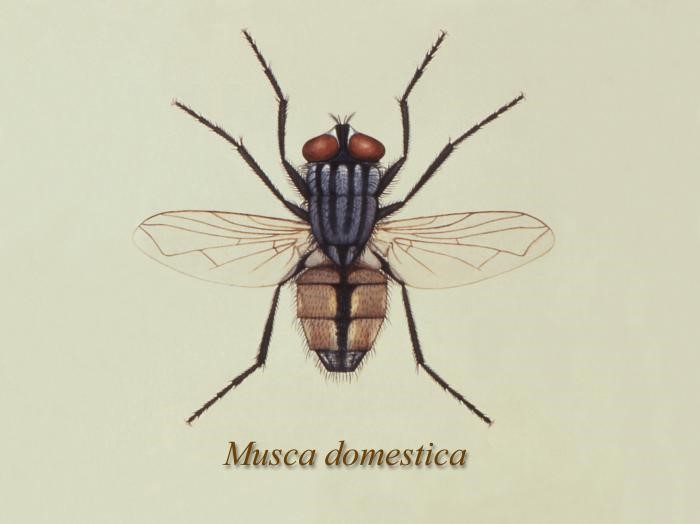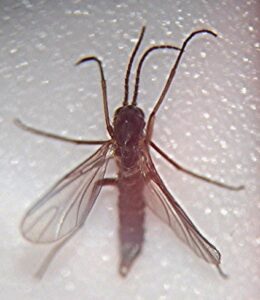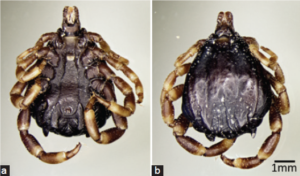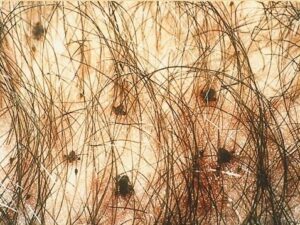House Fly:
General Description
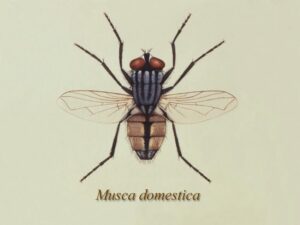
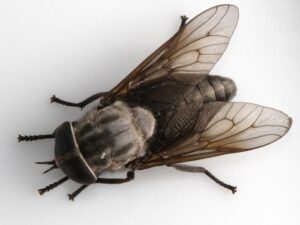
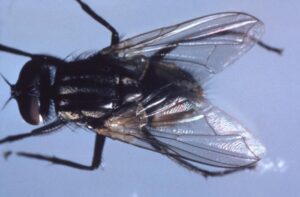
- The house fly adult length is about 6 to 7 Female adults are usually larger than males. The female can be distinguished from the male by the relatively wide space between the eyes (in males, the eyes almost touch). The head of the adult has reddish eyes and sponging mouthparts. The adult has the fourth wing vein sharply angled, and four lengthwise dark stripes on the top of the thorax. Its face has two velvety stripes that are silver above and gold below. The abdomen is grey or yellowish with a dark midline and irregular dark markings on the sides. The underside of the male is yellowish
- The eggs are white, small, oval eggs, and about 2 mm in length.
- Early instar larvae are 3 to 9 mm long, typically creamy whitish in color, and cylindrical but acuminate toward the The head contains one pair of dark hooks. The posterior spiracles are slightly raised and the spiracular openings are zigzag in shape which is completely surrounded by an oval black border.
- House fly pupa is about 8 mm
- Pupa is formed from the last larval skin which varies in color from yellow, red, and brown, to black as the pupa The shape of the pupa is quite different from the larva, being bluntly rounded at both ends.
Life Cycle and Common Characteristics
- The common house fly is a worldwide pest. It received its common name from being the most common fly found in and around homes.
- The house fly is a well-known global pest of both farms and
- The female lays egg in breeding sites that will provide sufficient moisture for larvae or maggot, they lay eggs in nearly any moist medium such as garbage or animal manure.
- Each adult female begins laying eggs a few days after hatching, laying a total of five to six batches of 75 to 100 eggs (can lay up to 500 eggs)
- The number of eggs produced is related to the female size which, itself, is especially a result of larval
- In warm weather eggs hatch in 12 to 24 hours into cream-colored larvae that burrow into the food material on which they hatched.
- Larvae grow and pupate in 4 to 7 days in warm weather.
- The larva development has three instars and the fully grown maggot is 7 to 12 mm
- The mature larva usually migrates away from its breeding source, seeking a dry place to pupate.
- Pupae complete their development in 2-6
- The emerging fly gets away from the pupal case using an alternately swelling and shrinking sac, called the ptilinum, on the front of its head which it uses like a pneumatic hammer to break through the
- Adults are ready to mate within a few hours after emerging.
- During warm weather, two or more generations may be completed in a month.
- Fly population builds up and is greatest in the early fall months.
- Animal manure, human excrement, garbage, decaying vegetable material, and ground contaminated with such organic matter are suitable materials.
- They are attracted to a wide variety of food materials, but they can ingest only liquid materials.
- Solid food is liquefied by means of regurgitated saliva. This liquefied food is then drawn up by the mouthparts and passed into the digestive tract.
- During daylight hours, house flies will rest on floors, walls, and ceilings indoors. Outdoors, flies rest on plants, the ground, fence wires, garbage cans, and other, similar surfaces.
- At night, flies rest principally on ceilings, electric wires, and dangling light cords indoors.
- In all situations, they prefer corners and edges or thin objects, such as wires and strings. Night resting places are usually near daytime sources of food, and are usually 1.5 to 2.5 meters off the ground.
Damages and Medical Implications
- The house fly is not only a nuisance pest but more importantly is it potential as a vector of disease pathogens. It has been found to be a transmitter of more than 130 different disease organisms people and animals. It plays a role in many of the major filth-borne disease outbreaks. These include typhoid fever, cholera, leprosy, trachoma virus, enteric infections, dysentery, and tuberculosis.
- Pathogenic organisms are picked up physically by flies from garbage, sewage, dead animals, vegetation materials, and other sources of filth, and then transferred through their mouthparts, vomitus, feces, and contaminated external body parts to human and animal food.

